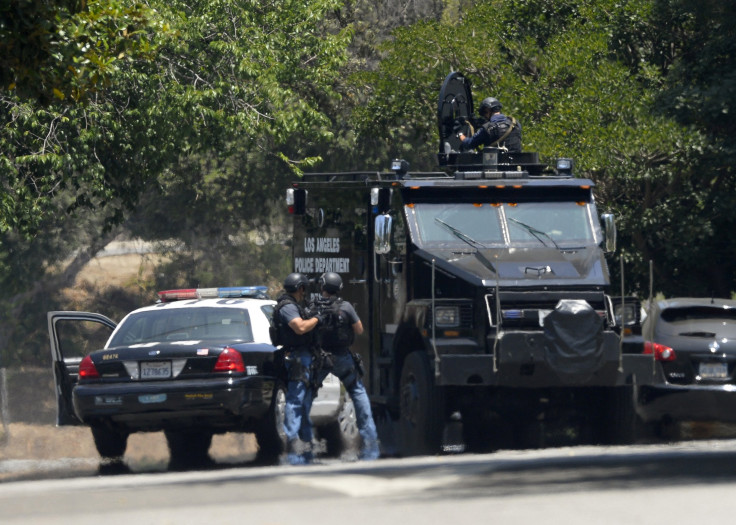SWAT Teams Increasingly Militarized, Target Minority Families For Drug Raids: ACLU

Police departments across America have become increasingly, and dangerously, militarized while loosening the standards for carrying out raids on homes where children and the elderly are present, the American Civil Liberties Union warns in a new report. The report, “War Comes Home,” comes not long after lawmakers began to debate how to curb that alarming trend.
The ACLU examined 818 SWAT incidents by nearly 20 law enforcement agencies across 11 states from July 2010 through October 2013. The sample size is a mere snapshot of what’s been happening inside the U.S. as the military turns its gaze from Iraq and Afghanistan and police are given more combat weapons and equipment, the civil liberties group found.
An assessment of that three-year period indicated that seven civilians, including a military veteran and young mother, were killed in police raids and another 46 people injured. No less remarkably, the ACLU found that 50 percent of the people affected by these raids were Latino or African-American, while 20 percent were Caucasian. The remainder involved more than one race or race unknown.
“Law enforcement agencies are increasingly using paramilitary squads to search people’s homes for drugs,” the report explained. “Neighborhoods are not war zones, and our police officers should not be treating us like wartime enemies.”
The tragic consequences that such an overwhelming police presence can have are clear upon learning of how some of the seven died. Tarika Wilson was a 26-year-old mother who was shot dead by SWAT officers while she was holding her 14-month-old son in a small town in Ohio. Eurie Stamp, a grandfather of 12, was watching a baseball game on TV in his living room dressed in his pajamas when police barged in, forced him to the floor, and fired.
The ACLU asserts in the report that, of the nearly two dozen police departments they sought to examine, not one turned over all of the information “necessary to undertake a thorough examination of police militarization.”
Part of the reason for that might be the widespread confusion over when SWAT teams should be deployed. The Guardian explained that the Los Angeles Police Department began training SWAT teams in the late 1960s so they would have a special forces-like unit capable of quelling riots and ending hostage situations safely.
That mindset has changed since Sept. 11, 2001, with the Department of Homeland Security and Department of Defense helping police obtain military equipment used in the Middle East for domestic law enforcement. Instead of resolving tense standoffs, though, the report found that increasingly armed SWAT teams are more often deployed for drug enforcement.
ACLU researchers discovered that 79 percent of all deployments were to execute search warrants on homes, often related to drug investigations. A mere 7 percent of deployments were for hostage, barricade or active-shooter situations.
“If the federal government gives the police a huge cache of military-style weaponry, they are highly likely to use it, even if they do not really need to,” the civil liberties group added.
Police officials in small towns and major metropolises alike have lobbied for more equipment and, in many cases, less oversight. One of the most popular vehicles is the Mine-Resistant Ambush Protected vehicle, or MRAP, most commonly found driving through the streets of Baghdad. Rep. Hank Johnson, D-Ga., started the national debate over whether vehicles like the MRAP are necessary for police departments that will never be forced to consider if an IED is waiting for them on Main Street.
“Something potentially sinister is happening across America, and we should stop and take notice before it changes the character of our country forever,” Johnson wrote in an opinion piece for USA Today earlier this year. “County, city and small-town police departments across the country are now acquiring free military-grade weapons that could possibly be used against the very citizens and taxpayers that not only fund the department but who the police are charged with protecting.”
The Georgia lawmaker went on to cite a North Carolina town that recently acquired Humvees and MRAPs and displayed them in a parade that, to some, resembled a Soviet parade in Red Square.
“Next door, in South Carolina, the Columbia Police Department also received a free MRAP from the Pentagon, which otherwise would have cost Columbia nearly $700,000 (though the city is responsible for all repairs and upkeep going forward). Their interim police chief, Ruben Santiago, justified the acquisition saying that the MRAP ‘will be a barrier between the public and a hostile person or situation such as a barricaded suspect with weapons who may be threatening someone’s life,’” Johnson went on.
“We are quickly redefining what a rational response to a security threat looks like.”
© Copyright IBTimes 2024. All rights reserved.











